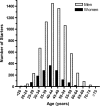The Western States 100-Mile Endurance Run: participation and performance trends
- PMID: 19915499
- PMCID: PMC2809551
- DOI: 10.1249/MSS.0b013e3181a8d553
The Western States 100-Mile Endurance Run: participation and performance trends
Abstract
Purpose: Examine changes in demographics of participants and performance trends at the Western States 100-Mile Endurance Run (WSER) since its inception in 1974.
Methods: Name, age, sex, and finish information was obtained on runners in the WSER from 1974 to 2007. Linear regression analyses, ANOVA, and t-tests were used to examine participation and performance trends.
Results: The mean age of participants increased (P < 0.001) to around 45 yr, with men being an average of 3 yr older (P < 0.001) than women. The increase in average age of starters was accounted for by the growth in participation among women >or=40 yr and men >or=50 yr, and by the decreasing participation among men <50 yr. Between 1986 and 2007, there was an increasing participation among women to around 20% of all starters. With this came improved (P < 0.01) finish times for the top 5 overall women and the top 5 women in the 30-39 and 40-49 yr age groups, whereas performances among the men did not improve over this time span. Average ages of the top performers increased (P <or= 0.002) since 1990 to the upper 30s for both sexes, but the fastest times among men were comparable across the 30-39 and 40-49 yr age groups.
Conclusions: Participation in the WSER has increased among women and older athletes, and the ages of the fastest runners at the WSER have gradually risen to the extent that these runners are older than the ages at which the fastest marathons are run. In contrast to what has been observed for men, finish times have improved for the top women across the last two decades at the WSER.
Figures












References
-
- Bam J, Noakes TD, Juritz J, Dennis SC. Could women outrun men in ultramarathon races? Med Sci Sports Exerc. 1997;29(2):244–7. - PubMed
-
- Brannen D, Milroy A. Across America on foot: The Bunion Derbies of 1928 and 1929. In: Allison D, editor. A Step Beyond: A Definitive Guide to Ultrarunning. UltraRunning Publishers; Weymouth (MA): 2004. pp. 280–9.
-
- Coyle EF. Physiological regulation of marathon performance. Sports Med. 2007;37(4–5):306–11. - PubMed
-
- Hoffman MD. Ultramarathon trail running comparison of performance-matched men and women. Med Sci Sports Exerc. 2008;40(9):1681–6. - PubMed
-
- Hoffman MD. Anthropometric characteristics of ultramarathoners. Int J Sports Med. 2008;29:1–4. - PubMed
Publication types
MeSH terms
Grants and funding
LinkOut - more resources
Full Text Sources

